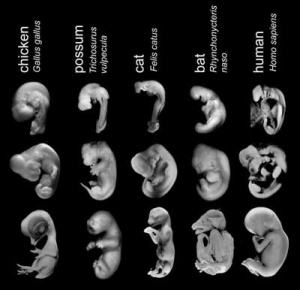EvoDevo Journal Club
Meeting Time Fall'10: Mondays, 1:00-2:00 in Biopharm 2nd floor fishbowl
Contents
Weekly Readings: Fall'10
9/13/10 Young et al. 2010. Development and the evolvability of human limbs. 9/20/10 Evolution, Development, and the Predictable Genome (Stern 2010). Preface and Chapters 1 and 2.
9/27/10 Evolution, Development, and the Predictable Genome (Stern 2010). Chapter 3.
10/04/10 Evolution, Development, and the Predictable Genome (Stern 2010) Chapters 4, 5.
10/11/10 Evolution, Development, and the Predictable Genome (Stern 2010) Chapters 6, 7.
10/18/10 Evolution, Development, and the Predictable Genome (Stern 2010) Chapters 8, 9.
10/25/10 Wasik et al. 2010. Beetle horns are regulated by the Hox gene, Sex combs reduced, in a species- and sex-specific manner.
11/01/10 Wang et al. 2010. Genomic patterns of pleiotropy and the evolution of complexity.
11/08/10 Heffer et al. 2010. Surprising flexibility in a conserved Hox transcription factor over 550 million years of evolution.
11/15/10 Tobler and Nijhout 2010. Developmental constraints on the evolution of wing-body allometry in Manduca sexta.
11/29/10 Ryan et al. 2010. The homeodomain complement of the ctenophore Mnemiopsis leidyi suggests that Ctenophora and Porifera diverged prior to the ParaHoxozoa.
Weekly Readings: Spring'10
2/10/10 Kopp 2009. Metamodels and phylogenetic replication: a systematic approach to the evolution of developmental pathways.
2/17/10 Draghi et al. 2010. Mutational robustness can facilitate adaptation.
2/24/10 Harrison et al. 2005. Independent recruitment of a conserved developmental mechanism during leaf evolution.
3/03/10 Tomescue 2009. Megaphylls, microphylls, and the evolution of leaf development.
3/17/03 Campas et al. 2010: Scaling and shear transformations capture beak shape variation in Darwin’s finches.
3/24/10 Venditti and Pagel 2010. Speciation as an active force in promoting genetic evolution.
3/31/10 Di-Poi et al. 2010. Changes in Hox genes' structure and function during the evolution of the squamate body plan.
3/07/10 Isaac Salazar-Ciudad and Jukka Jernvall 2010: A computational model of teeth and the developmental origins of morphological variation.
3/14/10 Liao et al. 2010: Contrasting genetic paths to morphological and physiological evolution.
3/21/10 Werner et al. 2010: Generation of a novel wing color pattern by the Wingless morphogen.
4/28/10 Zhang et al. 2010: Floral symmetry genes and the origin and maintenance of zygomorphy in a plant-pollinator mutualism.
5/05/10 Fraser and Schadt 2010: The quantitative genetics of robustness.
Weekly Readings: Fall'09
09/16/09: Dai et al. 2009. Characterization of microRNAs in cephalochordates reveals a correlation between microRNA repertoire homology and morphological similarity in chordate evolution.
09/23/09: Heimberg et al. 2008. MicroRNAs and the advent of vertebrate morphological complexity.
09/30/09: Bridham et al. 2009. An epistatic ratchet constrains the direction of glucocorticoid receptor evolution.
10/07/09 Heineman et al. 2009. Layers of evolvability in a bacteriophage life history trait.
10/14/09 Khalturin et al. 2009. More than just orphans: are taxonomically-restricted genes important in evolution?
10/21/09 Vargas and Wagner 2009. Frame-shifts in digit identity in bird evolution and Cyclopamine-treated wings.
10/28/09 1.) Organ et al. 2008. Molecular Phylogenetics of Mastodon and Tyrannosaurus Rex. 2.) Shweitzer et al. 2009. Biomolecular characterization and protein sequences of the campanian hadrosaur B. canadensis.
11/04/09 Barrick et al. 2009. Genome evolution and adaptation in a long-term experiment with Escherichia coli.
About the Journal Club:
This informal, interdepartmental discussion group is organized around recent literature and covers a broad range of topics relevant to evolutionary developmental biology.
Evo-devo is a growing and integrative field that draws on many biological disciplines. Student and faculty participants from all fields are welcome! We hope this less formal setting will also draw those curious about the field, as well as help to develop interdisciplinary contacts and ideas.
A few topics we have considered include:
comparative ontogenetics and its relevance to morphological evolution and novelty,
evolvability and evolutionary constraint,
gene regulatory network topology and robustness,
miRNAs and the evolution of complexity,
the evolution of genomic structure,
the prevalence of gene co-option,
questions of genetic and morphological homologies,
the evolutionary significance of developmental and phenotypic plasticity,
genetic assimilation,
the roles that genomic and ontogenetic features may play in speciation,
phylogenetic consideration of ontogenetic characters,
modeling of genetic, developmental, or cellular processes in evolution,
the role of genetic and protein networks in evolution,
as well as methods from allied fields that would fascilitate investigation into any of these topics.
As always we are willing and eager to field suggested readings.
Interested?
Join the Evo-Devo Journal Club!
To subscribe to the list send an e-mail to <majordomo@darwin.eeb.uconn.edu>.
Leave the subject blank.
In the message body type only "subscribe evo-devo".
Be sure not to use a signature in this message.
To unsubscribe from the list, do just as you did to subscribe, except make the message body "unsubscribe evo-devo".
To post messages to the listserv, address them to <evo-devo@darwin.eeb.uconn.edu>.
So, if you've found a paper or topic you think might be good for a discussion, feel free to share it with the group using this address!
If you have any comments or questions, please contact Frank Smith <frank.smith@uconn.edu>.
